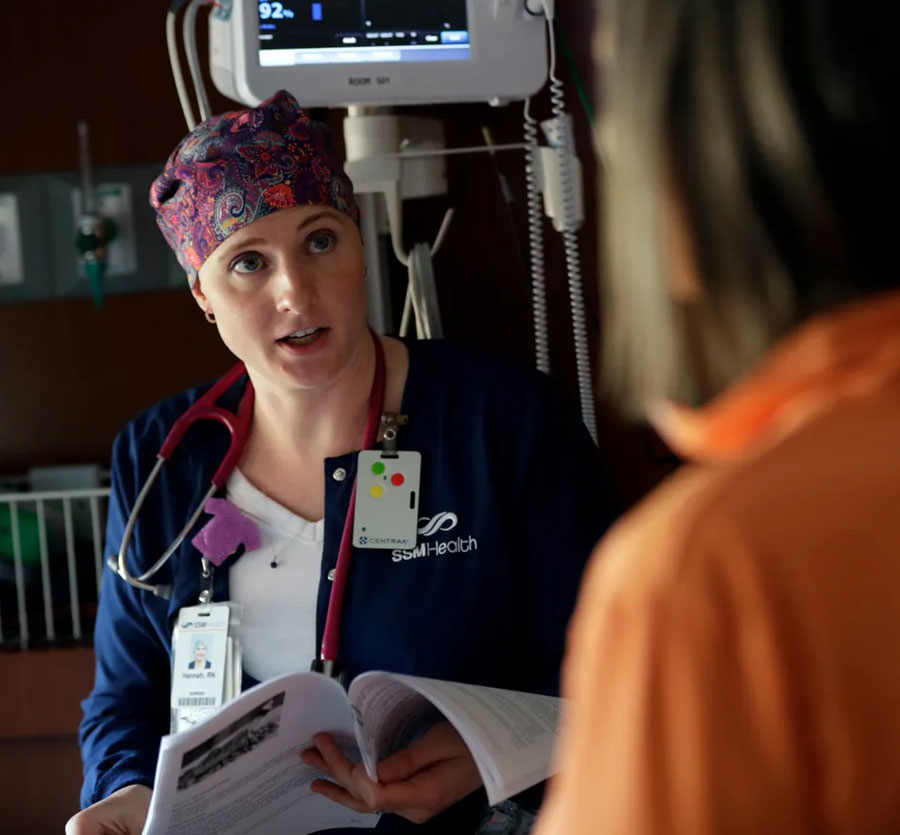
Hannah Pecora, RN, talks with Geri Mader to prepare for her mother’s discharge from SSM St. Agnes Hospital. Photo by Dan Powers, USA Today Network-Wisconsin
They Stayed in Nursing after COVID. But these Wisconsin Nurses will never be the Same.
Natalie Eilbert-USA Today Network, Wisconsin
FOND DU LAC – Hannah Pecora moves through the fifth floor of SSM Health St. Agnes Hospital in Fond du Lac with the confidence that comes with serving as a registered nurse since 2009. She wears a blue-and-pink print headscarf. It’s become a staple of her daily uniform.
Pecora was there when the first shock of COVID hit the staff, along with a stream of new medical guidelines.
She was there when the Alpha variant took hold, sweeping away the previous recommendations, and battering morale further. In just one weekend, nurses witnessed multiple deaths — slow, painful, unpredictable deaths. Some patients were older than Pecora, some younger. And she was in her mid-30s.
For the sickest patients, treating COVID is extremely uncomfortable, Pecora said. Patients are given heated high-flow oxygen, a type of respiratory support often delivered through a nasal cannula. Treatment of this kind means they have very limited space for movement, and the air pressure worsens fevered headaches.
Other patients sick enough to require a BiPAP mask had difficulty speaking. The mask fit tightly around their faces. They couldn’t eat or drink without the mask being removed. Some patients physically resisted the treatment.
Then came the Delta variant. Pecora worked 50- to 60-hour weeks — once hitting 78 — going days without seeing her son, who spent extra time in the care of his grandmother. She saw in her colleagues sunken, tired eyes, and they saw the same in her.
Medical guidelines focus on treating patients, not helping healthcare workers cut through the fog of grief.
Pecora saw one certified nursing assistant, a good friend of hers, rush to fix an oxygen mask that a patient had pulled off. The CNA started crying in the hallway, repeating, “I just don’t know if I can do this again.”
Then Pecora watched a patient younger than her die. This one left her reeling.
“As a nurse, we see a lot of patients dying. That’s part of what we do. But up until that point, most of them had been delirious, too lethargic to really be responding at the point of death,” Pecora said. “So, when I saw someone so aware of what was happening, it was just a very heavy feeling. And I know she must have been very, very brave to face death that way.”
Pecora started losing all her hair. It has never returned.
After COVID, more people leaving nursing than joining the field
St. Agnes Hospital, with its 149 beds and its exurban locale, is a classic example of a health system in middle America. The midsized hospital in Fond du Lac serves a tight-knit community of more than 44,000. It’s not uncommon for nurses to treat a patient they’ve known since childhood, or bantered with about children’s school projects, new jobs or old friends.
That intimate environment made everything the healthcare community experienced since March 2020, and particularly nurses dealing closest with patients, that much more visceral.
